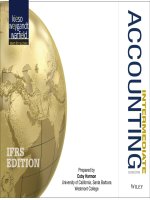Think critically 3rd edtion facione gittens 2016 chapter 10
Bạn đang xem bản rút gọn của tài liệu. Xem và tải ngay bản đầy đủ của tài liệu tại đây (6.88 MB, 20 trang )
© 2016 by Pearson Education, Inc.
Chapter 10
Snap Judgments - Risks and
Benefits of Heuristic Thinking
THINK CRITICALLY, FACIONE
& GITTENS
© 2016 by Pearson Education, Inc.
Learning Outcomes
• Explain, using examples, the difference
between system-1 and system-2 decision
making
• Explain, using examples, each of the
cognitive heuristics described in this
chapter, including its potential benefits and
risks
THINK CRITICALLY, FACIONE
& GITTENS
© 2016 by Pearson Education, Inc.
Chapter Opening Video
THINK CRITICALLY, FACIONE
& GITTENS
© 2016 by Pearson Education, Inc.
Our Two Human Decision-Making
Systems
• The two-systems approach to human
decision making
• The value of each system
THINK CRITICALLY, FACIONE
& GITTENS
© 2016 by Pearson Education, Inc.
The Two-systems Approach to
Human Decision Making
• System-1 thinking
– Relies on situational cues, salient memories,
and heuristic thinking to arrive at quick and
confident judgments
• System-2 thinking
– Useful for judgments in unfamiliar situations,
processing abstract concepts, and
deliberating
THINK CRITICALLY, FACIONE
& GITTENS
© 2016 by Pearson Education, Inc.
Model of Two-System Human
Decision Making
THINK CRITICALLY, FACIONE
& GITTENS
© 2016 by Pearson Education, Inc.
The Value of Each System
• System-1 can help get through day-to-day
activities while engaging System-2 on
some other topic of concern
• People do not store memories of system-1
while deliberating about something using
System-2
• Systems are capable of overriding each
other
THINK CRITICALLY, FACIONE
& GITTENS
© 2016 by Pearson Education, Inc.
Heuristics: Their Benefits and Risks
• Individual cognitive heuristics
• Heuristics in action
THINK CRITICALLY, FACIONE
& GITTENS
© 2016 by Pearson Education, Inc.
Individual Cognitive Heuristics
• Cognitive heuristics: Decision-making
shortcuts people rely on to expedite their
judgments on what to believe or do
– Satisficing
– Temporizing
– Affect
– Simulation
THINK CRITICALLY, FACIONE
& GITTENS
© 2016 by Pearson Education, Inc.
Individual Cognitive Heuristics
– Availability
– Representation
– Association
– Stereotyping
THINK CRITICALLY, FACIONE
& GITTENS
© 2016 by Pearson Education, Inc.
Individual Cognitive Heuristics
– Us vs. them
– Power differential
– Anchoring with adjustment
– Illusion of control
THINK CRITICALLY, FACIONE
& GITTENS
© 2016 by Pearson Education, Inc.
Explorer
THINK CRITICALLY, FACIONE
& GITTENS
© 2016 by Pearson Education, Inc.
Individual Cognitive Heuristics
– Optimistic bias
– Hindsight bias
– Elimination by aspect
– Loss and risk aversion
– All or nothing
THINK CRITICALLY, FACIONE
& GITTENS
© 2016 by Pearson Education, Inc.
Discussion Question
• Discuss examples of when someone gave
you advice about an important matter and
their only argument was that your situation
reminded them of their own or someone
else’s situation
THINK CRITICALLY, FACIONE
& GITTENS
© 2016 by Pearson Education, Inc.
Heuristics in Action
• Cognitive heuristics expedite one’s
thinking by generating ideas, but not
necessarily reflectively
THINK CRITICALLY, FACIONE
& GITTENS
© 2016 by Pearson Education, Inc.
Heuristics and Possible Errors from
Their Misapplication
THINK CRITICALLY, FACIONE
& GITTENS
© 2016 by Pearson Education, Inc.
Heuristics and Possible Errors from
Their Misapplication
THINK CRITICALLY, FACIONE
& GITTENS
© 2016 by Pearson Education, Inc.
Heuristics and Possible Errors from
Their Misapplication
THINK CRITICALLY, FACIONE
& GITTENS
© 2016 by Pearson Education, Inc.
Sketchnote Video
THINK CRITICALLY, FACIONE
& GITTENS
© 2016 by Pearson Education, Inc.









